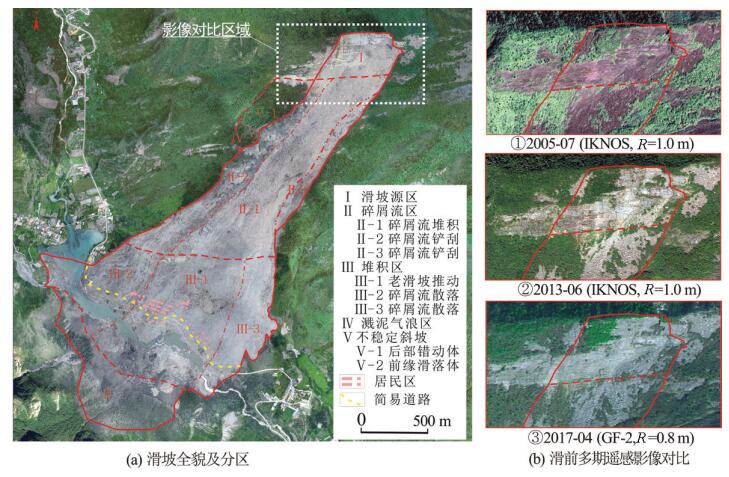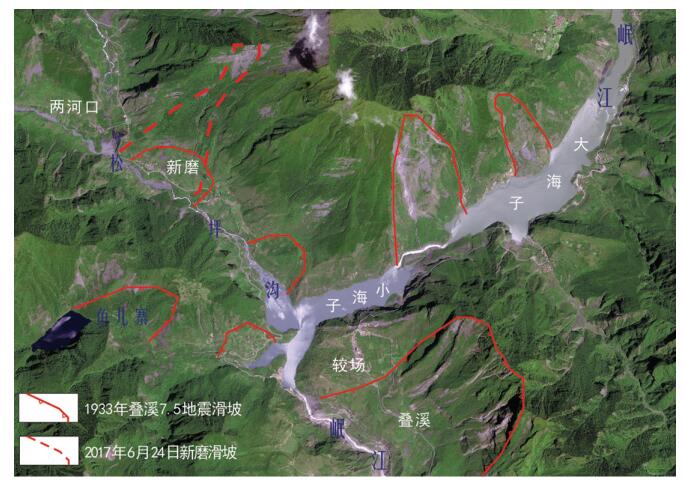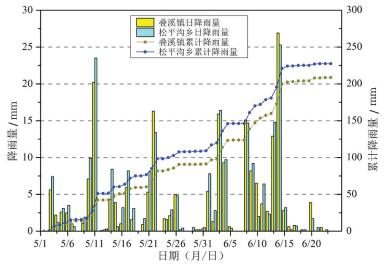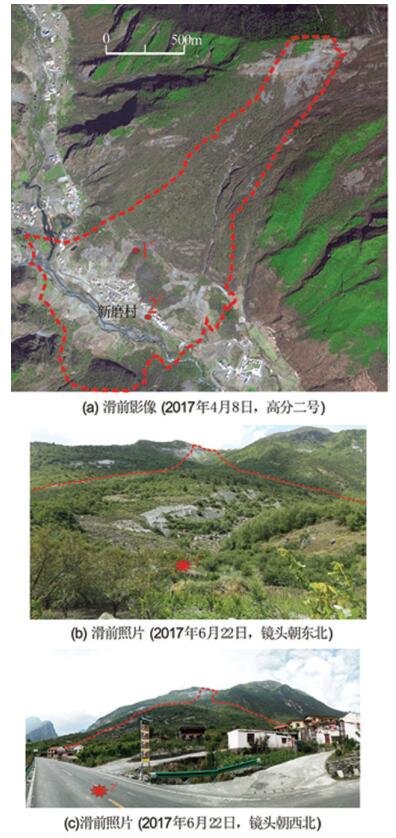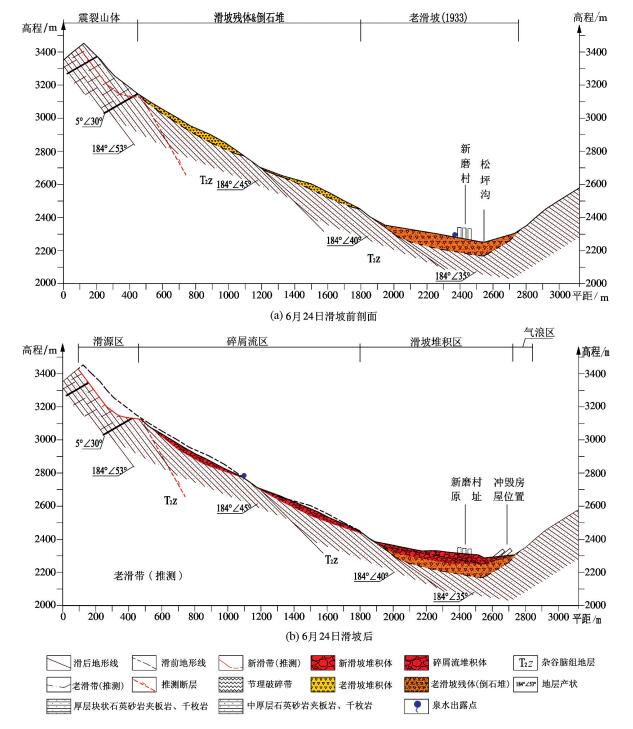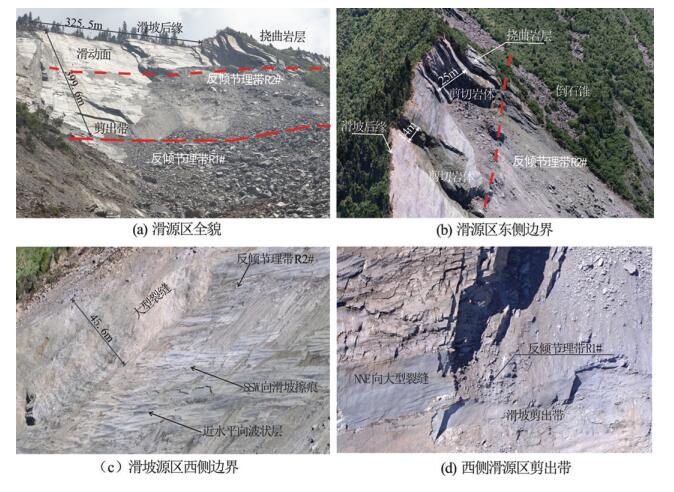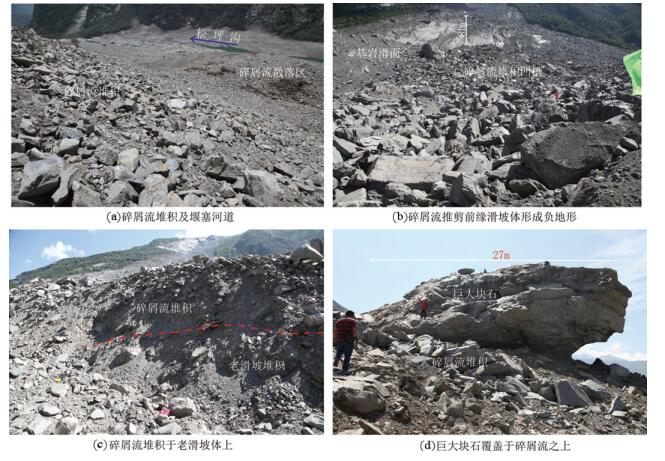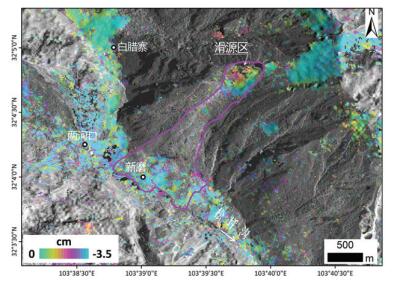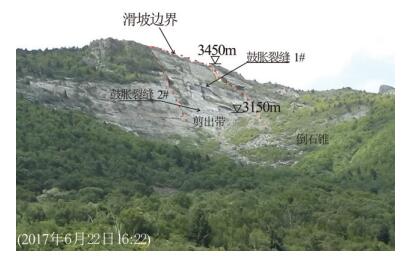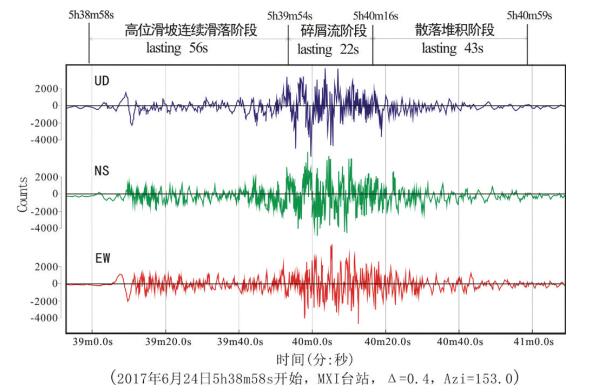Long runout geological disaster initiated by the ridge-top rockslide in a strong earthquake area: A case study of the Xinmo landslide in Maoxian County, Sichuan Province
-
摘要:
近年来,在汶川地震等强震区常发生一种特大的高位滑坡地质灾害,它从高陡斜坡上部位置剪出并形成凌空加速坠落,具有撞击粉碎效应和动力侵蚀效应,导致滑体解体碎化,从而转化为高速远程碎屑流滑动或泥石流流动,并铲刮下部岩土体,使体积明显增加。新磨滑坡就是这种典型,它发生于2017年6月24日,滑坡后缘高程约3450m,前缘高程约2250 m,高差1200 m,水平距离2800 m,堆积体体积达1637×104 m3,摧毁了新磨村村庄,导致83人死亡。新磨滑坡地处叠溪较场弧形构造带前弧西翼,母岩为中三叠统中厚层变砂岩夹板岩,是1933年叠溪Ms7.5级震中区(烈度X度)和汶川Ms8.0级强震区(烈度IX度),形成震裂山体。滑源区分布多组不连续结构面,将厚层块状岩体分割成碎裂块体,在高程3150~3450 m区间形成明显的压裂鼓胀区,特别是存在2组反倾节理带,具有典型的“锁固段”失稳机理。滑坡体高位剪出滑动,连续加载并堆积于斜坡体上部,体积达390×104 m3,导致残坡积岩土层失稳并转化为管道型碎屑流;碎屑流高速流滑至斜坡下部老滑坡堆积体后,因前方地形开阔、坡度变缓,转化为扩散型碎屑流散落堆积,具有“高速远程”成灾模式。据此,可建立强震山区高位滑坡的早期识别方法,当陡倾山脊存在大型岩质高位滑坡时,应当考虑冲击作用带来的动力侵蚀效应和堆积加载效应,特别是沿沟谷赋存丰富的地下水时,发生高速远程滑坡的可能性将明显增加。因此,在地质灾害调查排查中,在高位岩质滑坡剪出口下方的斜坡堆积体上的聚居区等应划定为地质灾害危险区。在强震山区地质灾害研究中,不仅应采用静力学理论分析滑坡的失稳机理,而且应采用动力学方法加强运动过程的成灾模式研究。
Abstract:In recent years, a typical type of catastrophic ridge-top (or high-position) rockslide often occur in the strong earthquakes such as the Wenchuan earthquake. It exits out from the upper part of the steep slope and forms a volley fall with impact and crushing effect and dynamic erosion effect, causing the slide body to disintegrate and fragment, which transforms into rapid and long run-out avalanche debris or debris flow, and entraining the lower part of rock and soil mass, so that the volume increased significantly. The Xinmo landslide is this typical, it occurred at Maoxian County, Sichuan Province on June 24, 2017. The elevation of the crown of the Xinmo landslide was about 3450 m and the front edge was about 2250m. The height difference of landslide was 1200m, and the horizontal distance was about 2800 m. Its volume was up to 16.37 million m3. The landslide buried the Xinmo Village, leading to the death of 83 people. The Xinmo landslide was located on the western wing of the Jiaochang arc-shaped tectonics. Its parent rocks were the medium to thick layered metamorphic sandstone intercalated with slate in the Middle Triassic. The region was not only the epicenter area of the Diexi earthquake with magnitude 7.5 in 1933 (the intensity of the earthquake was X) but also the strong earthquake-affected area of the Wenchuan Ms8.0 earthquake in 2008 (the intensity was IX). The mountains, especially the ridge-top rockmass, were fractured/cracked due to the strong earthquakes. There were multiple groups of discontinuous structural planes in the sliding source zone, and hence the thick blocky rock mass was cracked into fragmented blocks, and the bugling area was formed at the elevation varying from 3150 to 3450 meter. In particular, there were two sets of anti-dip large joints in the sliding source area, indicating a typical failure mechanism "locked-section". Rockslide with a volume of 3.9 million m3 exited and continuously accumulated at the back of previous residual landslide. The "overload effect" triggered the slope instability under the exit and transferred into long runout channeled avalanche debris. Because the terrain was wide and the slope angle gradually decreased, avalanche debris converted to diffused one and then to scattered accumulation. The Xinmo landslide presents a typical disaster mode of the rapid and long runout initialed due to rockslide at ridge-top in strong earthquake area. A new method should be established to recognize this type of landslides. Wherever there are large-scale rockslides in steep ridge-top region, the "dynamic erosion effect" and the "overloading effect" on the previous accumulation and the talus of slope due to impact processes should be considered. Especially in the place where there is abundant groundwater along the gully, the possibility of a rapid and long runout rockslide-avalanche debris will increase. Therefore, in conducting the investigation of geological disaster, the town, village or other populated areas should be zoned as risk area on the previous landslide accumulation of slope below the exit of the rockslide at the ridge-top. The authors emphasize that, in the strong earthquake mountainous regions, the static balance method for the landslide stability should be considered, and the dynamic research on the landslide runout processes and the disaster mode should be strengthened.
-
Key words:
- ridge-top landslide /
- avalanche debris /
- strong earthquake area /
- Maoxian County
-

-
表 1 茂县新磨滑坡物源和堆积分区
Table 1. Zoning of material sources and accumulation of the Xinmo landslide, Maoxian County

-
Catane S G, Cabria H B, Jr C P T, Jr R M S, Zarco M A H, Pioquinto W C.2007.Catastrophic rockslide-debris avalanche at St.Bernard, Southern Leyte, Philippines[J].Landslides, 4(1):85-90. doi: 10.1007/s10346-006-0050-3
Chen Zuyu, Meng Xingmin, Yin Yueping, Dijkstra T, Winter M, Wasowski J.2016.Landslide research in China[J].Quarterly Journal of Engineering Geology & Hydrogeology, 49(1-4):qjegh2016-100. https://www.researchgate.net/.../310757610_Landslide_Research_in_China
Fan Xuanmei, Xu Qiang, Scaringi G, Dai Lanxin, Li Weile, Dong Xiujun, Zhu Xing, Pei Xiangjun, Dai Keren, Havenith HansBalder.2017.Failure mechanism and kinematics of the deadly June 24th 2017 Xinmo landslide, Maoxian, Sichuan, China[J].Landslides, online DOI 10.1007/s10346-017-0907-7. doi: 10.1007/s10346-017-0907-7
Huang Runqiu, Li Weile.2011.Formation, distribution and risk control of landslides in China[J].Journal of Rock Mechanics and Geotechnical Engineering, 3(2):97-116. doi: 10.3724/SP.J.1235.2011.00097
Hungr O, McDougall S.2009.Two numerical models for landslide dynamic analysis[J].Comput Geosci, 35(5):978-92. doi: 10.1016/j.cageo.2007.12.003
Sassa K, He B, Dang K, Nagai O, Takara K.2014.Plenary:progress in landslide dynamics[C]//Sassa K, Canuti P, Yin Y P (editors) Landslide science for a safer geoenvironment.Switzerland:Springer International Publishing; 37-67.
Scheidegger A E.1973.On the prediction of the reach and velocity of catastrophic landslides[J].Rock Mech Rock Eng, 5:11-40. https://link.springer.com/article/10.1007/BF01301796
Su Lijun, Hu K H, Zhang W F, Wang J, Lei Y, Zhang CL, Cui P, Alessandro Pasuto, Zheng QH.2017.Characteristics and triggering mechanism of Xinmo landslide on 24 June 2017 in Sichuan, China[J].Journal of Mountain Science, 14(9):1689-1700. doi: 10.1007/s11629-017-4609-3
Wen Mingsheng, Chen Hongqi, Zhang Mingzhi, Chu Hongliang, Wang Wenpei, Zhang Nan, Huang Zhe.2017.Characteristics and formation mechanism analysis of the "6·24" catastrophic landslide of the June 24 of 2017, at Maoxian, Sichuan[J].Chinese Journal of Geological Hazards and Control, 28(3):1-7(in Chinese with English abstract). https://link.springer.com/article/10.1007/s11069-017-3026-9
Xu Qiang, Li Weile, Dong Xiujun, Xiao Xianxuan, Fan Xuanmei, PeiXiangjun.The Xinmocun landslide on June 24, 2017 in Maoxian, Sichuan:characteristics and failure mechanism., 2017, 36(11):2612-2628. https://www.researchgate.net/publication/320318336_Failure...
Xu Qiang, Li Weile, Dong Xiujun, Xiao Xianxuan, Fan Xuanmei, Pei Xiangjun.2018.The Xinmocun Landslide on June 24, 2017 in Diexi, Maoxian, Sichuan:Characteristics and Failure Mechanism[J].Chinese Journal of Rock Mechanics and Engineering, (in Press). https://link.springer.com/article/10.1007/s11069-017-3026-9
Xu Qiang, Zhang S, Li WL.2011.Spatial distribution of large-scale landslides induced by the 5.12 Wenchuan earthquake[J].Journal of Mountain Science, 8(2):246-260. doi: 10.1007/s11629-011-2105-8
Xu Xiangning, Wang Lansheng.2012.Mountain hazard caused by earthquake in Songping branch, the Upper Min River and its controlling[J], The Chinese Journal of Geological Hazard and Control, 13(2):31-35(in Chinese with English abstract).
Yin Yueping, Zheng Wamo, Li Xiaochun.2011a.Catastropic landslides associated with the M8.0 Wenchuan earthuqake[J].Bulletin of engineering Geology & the Environment, 70(1):15-32. https://link.springer.com/article/10.1007/s10064-010-0334-7
Yin Yueping, Sun Ping, Zhu Jiliang, Yang Shengyun.2011b.Research on catastrophic rock avalanche at Guanling, Guizhou, China[J].Landslides, 8(4):517-525. doi: 10.1007/s10346-011-0266-8
Yin Yueping, Cheng Yuliang, Liang Jingtao, Wang Wenpei.2016.Heavy-rainfall-induced catastrophic rockslide-debris flow at Sanxicun, Dujiangyan, after the Wenchuan Ms 8.0 earthquake[J].Landslides, 13(1):9-23. doi: 10.1007/s10346-015-0554-9
Yin Yueping, Wang Wenpei, Zhang Nan, Yan Jingkai, Wei Yunjie.2017.The June 2017 Maoxian Landslide:Geological Disaster in An Earthquake Area after the Wenchuan Ms8.0 Earthquake[J].Sci China Tech.Sci., 2017, 60:doi:10.1007/s11431-017-9148-2.
Zhang Ming, McSaveney M J.2017.Rock avalanche deposits store quantitative evidence on internal shear during runout[J].Geophysical Research Letters, 44:doi:10.1002/2017GL073774.
Zhang Yongshuang, Cheng Yuliang, Yin Yueping, Lan Hengxing.2014.High-position debris flow:a long-term active geohazard after the wenchuan earthquake.Engineering Geology, 180(180):45-54. https://www.sciencedirect.com/science/article/pii/S0013795214001227
Zhao Yong.2017.Analysis of movement process of Maoxian landslide, Sichuan[R].Beijing:China Earthquake Networks Center (in Chinese).
温铭生, 陈红旗, 张鸣之, 褚宏亮, 王文沛, 张楠, 黄喆.2017.四川茂县"6.24"特大滑坡特征与成因机制分析[J].中国地质灾害与防治学报, 28(3):1-7.
许强, 李为乐, 董秀军, 肖先煊, 范宣梅, 裴向军.四川茂县叠溪镇新磨村滑坡特征与成因机制初步研究[J].岩石力学与工程学报, 2017, 36(11):2612-2628. http://www.cnki.com.cn/Journal/B-B3-YSLX-2017-11.htm
许强, 李为乐, 董秀军, 肖先煊, 范宣梅, 裴向军.2018.四川茂县叠溪镇新磨村滑坡特征与成因机理初步研究[J].岩石力学与工程学报, (待刊). http://bianke.cnki.net/Home/Corpus/14112.html
许向宁, 王兰生.2002.岷江上游松坪沟地震山地灾害与生态环境保护[J].中国地质灾害与防治学报, 13(2):31-35. http://www.cqvip.com/QK/98314X/200202/6521123.html
赵永. 2017. 四川6. 24茂县滑坡过程分析[R]. 北京: 中国地震台网中心.
-



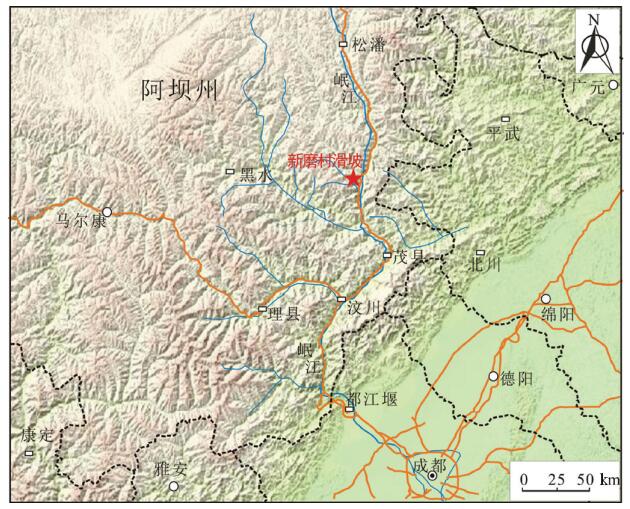
 下载:
下载:
